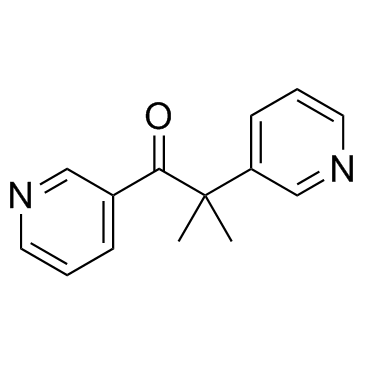metyrapone

metyrapone structure
|
Common Name | metyrapone | ||
|---|---|---|---|---|
| CAS Number | 54-36-4 | Molecular Weight | 226.274 | |
| Density | 1.1±0.1 g/cm3 | Boiling Point | 384.4±22.0 °C at 760 mmHg | |
| Molecular Formula | C14H14N2O | Melting Point | 53-56ºC | |
| MSDS | Chinese USA | Flash Point | 189.3±28.8 °C | |
| Symbol |

GHS07 |
Signal Word | Warning | |
|
Cytochrome P450-dependent metabolism of caffeine in Drosophila melanogaster.
PLoS ONE 10(2) , e0117328, (2015) Caffeine (1, 3, 7-trimethylxanthine), an alkaloid produced by plants, has antioxidant and insecticide properties that can affect metabolism and cognition. In vertebrates, the metabolites derived from caffeine have been identified, and their functions have bee... |
|
|
The different roles of glucocorticoids in the hippocampus and hypothalamus in chronic stress-induced HPA axis hyperactivity.
PLoS ONE 9(5) , e97689, (2014) Hypothalamus-pituitary-adrenal (HPA) hyperactivity is observed in many patients suffering from depression and the mechanism underling the dysfunction of HPA axis is not well understood. Chronic stress has a causal relationship with the hyperactivity of HPA ax... |
|
|
Cheminformatics analysis of assertions mined from literature that describe drug-induced liver injury in different species.
Chem. Res. Toxicol. 23 , 171-83, (2010) Drug-induced liver injury is one of the main causes of drug attrition. The ability to predict the liver effects of drug candidates from their chemical structures is critical to help guide experimental drug discovery projects toward safer medicines. In this st... |
|
|
Translating clinical findings into knowledge in drug safety evaluation--drug induced liver injury prediction system (DILIps).
J. Sci. Ind. Res. 65(10) , 808, (2006) Drug-induced liver injury (DILI) is a significant concern in drug development due to the poor concordance between preclinical and clinical findings of liver toxicity. We hypothesized that the DILI types (hepatotoxic side effects) seen in the clinic can be tra... |
|
|
Protracted effects of chronic stress on serotonin-dependent thermoregulation.
Stress 18 , 668-76, (2015) Chronic stress is known to affect serotonin (5HT) neurotransmission in the brain and to alter body temperature. The body temperature is controlled in part, by the medial preoptic area (mPOA) of the hypothalamus. To investigate the effect of chronic stress on ... |
|
|
FDA-approved drug labeling for the study of drug-induced liver injury.
Drug Discov. Today 16 , 697-703, (2011) Drug-induced liver injury (DILI) is a leading cause of drugs failing during clinical trials and being withdrawn from the market. Comparative analysis of drugs based on their DILI potential is an effective approach to discover key DILI mechanisms and risk fact... |
|
|
Comparative chemometric modeling of cytochrome 3A4 inhibitory activity of structurally diverse compounds using stepwise MLR, FA-MLR, PLS, GFA, G/PLS and ANN techniques.
Eur. J. Med. Chem. 44 , 2913-22, (2009) Twenty-eight structurally diverse cytochrome 3A4 (CYP3A4) inhibitors have been subjected to quantitative structure-activity relationship (QSAR) studies. The analyses were performed with electronic, spatial, topological, and thermodynamic descriptors calculate... |
|
|
Inhibition of endogenous glucocorticoid synthesis aggravates lung injury triggered by septic shock in rats.
Int. J. Exp. Pathol. 96 , 133-9, (2015) The aim of this study was to determine the effects of previous administration of metyrapone (met) on the acute lung injury (ALI) induced by caecal ligation and puncture (CLP) and to explore met's relationship with endogenous glucocorticoids (GCs) as measured ... |
|
|
Development of a phospholipidosis database and predictive quantitative structure-activity relationship (QSAR) models.
Toxicol. Mech. Methods 18 , 217-27, (2008) ABSTRACT Drug-induced phospholipidosis (PL) is a condition characterized by the accumulation of phospholipids and drug in lysosomes, and is found in a variety of tissue types. PL is frequently manifested in preclinical studies and may delay or prevent the dev... |
|
|
Essential roles of endogenous glucocorticoids and TNF/TNFR1 in promoting bone-marrow eosinopoiesis in ovalbumin-sensitized, airway-challenged mice.
Life Sci. 94(1) , 74-82, (2014) Stress mechanisms paradoxically contribute to allergic episodes in humans and mice. Glucocorticoids (GC) and interleukin (IL)-5 synergically upregulate murine bone-marrow eosinophil production. Here we explored the role of endogenous GC in allergen-stimulated... |